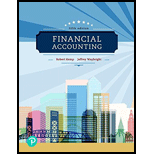
Financial Accounting (5th Edition) (What's New in Accounting)
5th Edition
ISBN: 9780134727790
Author: Robert Kemp, Jeffrey Waybright
Publisher: PEARSON
expand_more
expand_more
format_list_bulleted
Concept explainers
Textbook Question
Chapter 2, Problem 8SE
Types of accounts and effects of debits and credits (Learning Objective 2) 5-10 min.
Complete the following table. For each account listed, identify the type of account, how the account is increased (debit or credit), and how the account is decreased (debit or credit). Use the most detailed account type appropriate.
| Account | Type | ↑ | ↓ |
| Office Equipment | Asset | Dr. | Cr. |
| Dividends | |||
| Service Revenue | |||
| Accounts Payable | |||
| Rent Expense | |||
| Cash |
Expert Solution & Answer
Want to see the full answer?
Check out a sample textbook solution
Students have asked these similar questions
True Ans general Accounting
What is its accounts receivable turnover of this financial accounting question?
Answer financial accounting
Chapter 2 Solutions
Financial Accounting (5th Edition) (What's New in Accounting)
Ch. 2 - The order in which assets were listed and...Ch. 2 - Prob. 2DQCh. 2 - How is revenue related to retained earnings?Ch. 2 - Prob. 4DQCh. 2 - Prob. 5DQCh. 2 - Prob. 6DQCh. 2 - Prob. 7DQCh. 2 - Distinguish between journalizing and posting.Ch. 2 - True or false: If the trial balance is in balance,...Ch. 2 - When it is time to prepare the financial...
Ch. 2 - Which sequence of actions correctly summarizes the...Ch. 2 - Prob. 2SCCh. 2 - Prob. 3SCCh. 2 - Prob. 4SCCh. 2 - Prob. 5SCCh. 2 - Which journal entry records obtaining a bank loan...Ch. 2 - RV Wholesale, Inc., paid 1,200 for supplies and...Ch. 2 - Prob. 8SCCh. 2 - Prob. 9SCCh. 2 - Prob. 10SCCh. 2 - Prob. 11SCCh. 2 - Prob. 12SCCh. 2 - Prob. 1SECh. 2 - Prob. 2SECh. 2 - Prob. 3SECh. 2 - Prob. 4SECh. 2 - Accounting terminology (Learning Objectives 2, 3, ...Ch. 2 - Effects of debits and credits on accounts...Ch. 2 - Balancing accounts and normal balances (Learning...Ch. 2 - Types of accounts and effects of debits and...Ch. 2 - Re-creating journal entries from T-account...Ch. 2 - Journalizing transactions (Learning Objective 3)...Ch. 2 - Prob. 11SECh. 2 - Prob. 12SECh. 2 - Prob. 13SECh. 2 - Accounting terminology (Learning Objectives 1, 2,...Ch. 2 - Prob. 15AECh. 2 - Journalizing transactions (Learning Objective 3)...Ch. 2 - Prob. 17AECh. 2 - Balancing accounts and preparing a trial balance...Ch. 2 - Prob. 19AECh. 2 - Prob. 20AECh. 2 - Prob. 21AECh. 2 - Prob. 22AECh. 2 - Prob. 23BECh. 2 - Prob. 24BECh. 2 - Prob. 25BECh. 2 - Balancing accounts and preparing a trial balance...Ch. 2 - Recording transactions and preparing a trial...Ch. 2 - Prob. 28BECh. 2 - Prob. 29BECh. 2 - Prob. 30BECh. 2 - Prob. 31APCh. 2 - Prob. 32APCh. 2 - Journalizing, posting, and preparing a trial...Ch. 2 - Prob. 34APCh. 2 - Preparing a trial balance, income statement,...Ch. 2 - Prob. 36APCh. 2 - Prob. 37BPCh. 2 - Prob. 38BPCh. 2 - Prob. 39BPCh. 2 - Prob. 40BPCh. 2 - Prob. 41BPCh. 2 - Prob. 42BPCh. 2 - Prob. 1CECh. 2 - Prob. 1CPCh. 2 - Prob. 1CFSAPCh. 2 - Prob. 1EIACh. 2 - Prob. 2EIACh. 2 - Prob. 1FACh. 2 - Prob. 1IACh. 2 - Prob. 1SBACh. 2 - Prob. 1WC
Knowledge Booster
Learn more about
Need a deep-dive on the concept behind this application? Look no further. Learn more about this topic, accounting and related others by exploring similar questions and additional content below.Similar questions
arrow_back_ios
SEE MORE QUESTIONS
arrow_forward_ios
Recommended textbooks for you
 Financial AccountingAccountingISBN:9781305088436Author:Carl Warren, Jim Reeve, Jonathan DuchacPublisher:Cengage LearningCentury 21 Accounting Multicolumn JournalAccountingISBN:9781337679503Author:GilbertsonPublisher:Cengage
Financial AccountingAccountingISBN:9781305088436Author:Carl Warren, Jim Reeve, Jonathan DuchacPublisher:Cengage LearningCentury 21 Accounting Multicolumn JournalAccountingISBN:9781337679503Author:GilbertsonPublisher:Cengage College Accounting, Chapters 1-27AccountingISBN:9781337794756Author:HEINTZ, James A.Publisher:Cengage Learning,
College Accounting, Chapters 1-27AccountingISBN:9781337794756Author:HEINTZ, James A.Publisher:Cengage Learning, Excel Applications for Accounting PrinciplesAccountingISBN:9781111581565Author:Gaylord N. SmithPublisher:Cengage Learning
Excel Applications for Accounting PrinciplesAccountingISBN:9781111581565Author:Gaylord N. SmithPublisher:Cengage Learning


Financial Accounting
Accounting
ISBN:9781305088436
Author:Carl Warren, Jim Reeve, Jonathan Duchac
Publisher:Cengage Learning

Century 21 Accounting Multicolumn Journal
Accounting
ISBN:9781337679503
Author:Gilbertson
Publisher:Cengage

College Accounting, Chapters 1-27
Accounting
ISBN:9781337794756
Author:HEINTZ, James A.
Publisher:Cengage Learning,


Excel Applications for Accounting Principles
Accounting
ISBN:9781111581565
Author:Gaylord N. Smith
Publisher:Cengage Learning
ACCOUNTING BASICS: Debits and Credits Explained; Author: Accounting Stuff;https://www.youtube.com/watch?v=VhwZ9t2b3Zk;License: Standard Youtube License